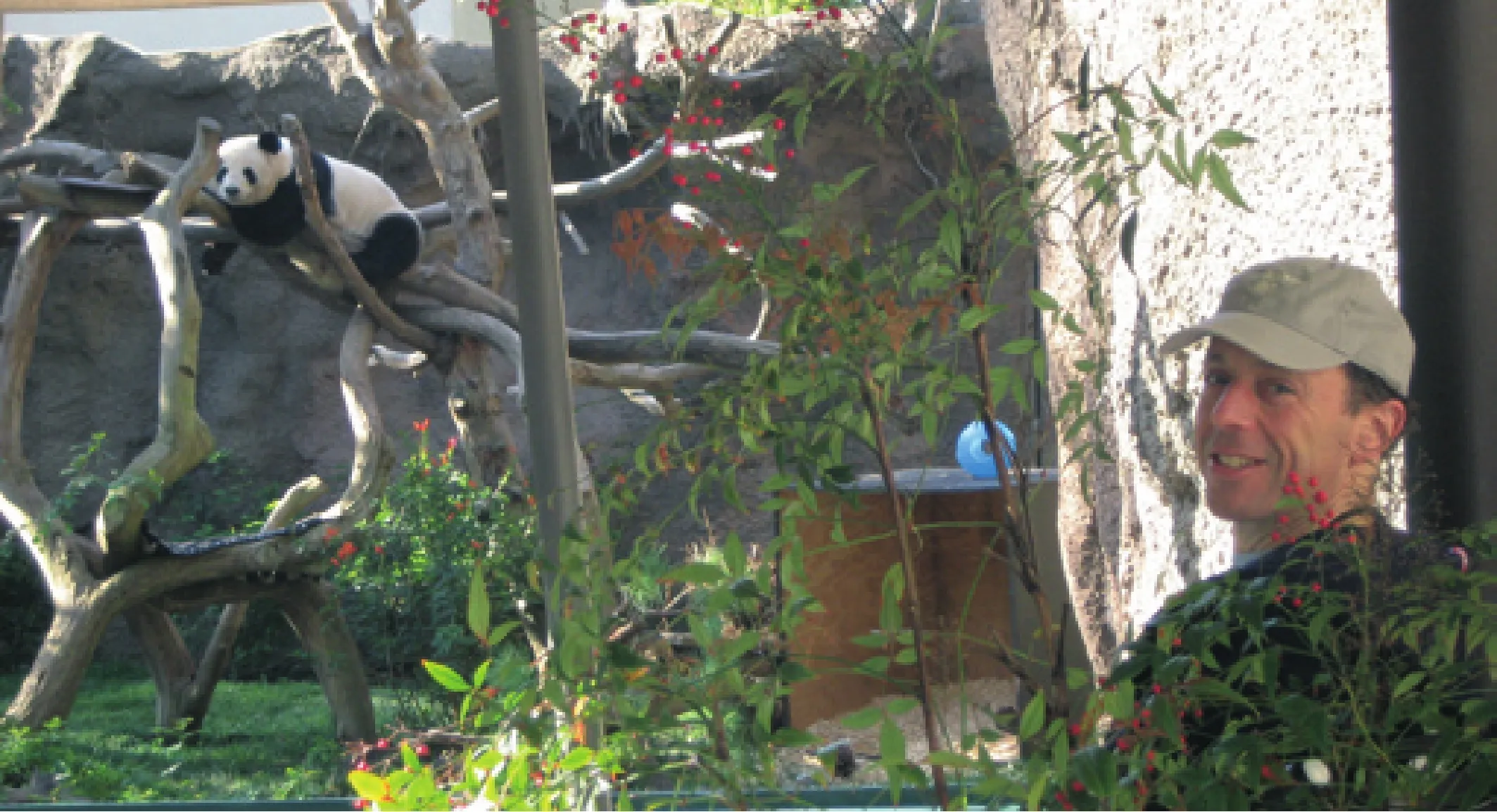Caring for the Giant Pandas’ Future
2010-10-14ByTANGYUANKAI
By TANG YUANKAI
Caring for the Giant Pandas’ Future
By TANG YUANKAI
U.S. corporation works together w ith Chinese organizations on conservation of the rare species

PANDA VOLUNTEER: Broad com em p loyee and San Diego Zoo vo lunteer Steven Larky w ith a giant panda on loan from China at the San Diego Zoo in the United States
A long-term partnership was formed in October by American corporation Broadcom, Broadcom Foundation,and the San Diego Zoo, together w ith China Wolong National Natural Reserve and the Institute of Zoology of the Chinese Academy of Sciences (CAS) to study giant panda protection and breeding.
Having lived on the Earth for more than 2.4 million years, giant pandas are one of the most well-known endangered species in the world.
Adopting innovation and new technology is of vital signifi cance for the protection of the panda, both in tracking the animals in the w ild through the global positioning system (GPS) and the rebuilding of digital breeding and protection facilities at the Wolong Reserve which were severely damaged in W enchuan earthquake on M ay 12. 2008, said Broadcom, a major innovator in technology and global leader in sem iconductors for w ired and w ireless communications.
W o long, located in the W enchuan County in southw est China’s Sichuan Province, is known as the home of giant pandas. It became a natural reserve in 1963, and is currently the largest integrated national natural reserve for giant pandas and other rare w ildlife and alpine ecosystems in China.During the Wenchuan earthquake, the 32 giant panda shelters in China Conservation and Research Center for Giant Panda (CCRCGP)were completely destroyed. Of the 63 giant pandas raised there, two died and one went m issing.
“Currently there are about 300 pandas living in the reserve,” said Wang Pengyan,Deputy Director of the Wolong Reserve.“W ith the support and selfless assistance of all sectors of the society, we have successfully completed tasks of emergency rescue and settlement of pandas after the earthquake,and now everything is returning to normal.”
“Broadcom engineers are hard at work on innovations in GPS, W i-Fi, Bluetooth and other technology; w ireless handheld devices;and telecommunication, communications and computer infrastructure systems. We hope someday these technologies will help in the tracking, preservation and protection of giant pandas,” said Broadcom CEO Scott McGregor in Beijing.
He said the corporation w ill also provide professional technology support to giant panda researchers through its Chinese staff’s voluntary on-line services.
The cooperation between Broadcom and the Chinese institutions came about because a Broadcom employee was a volunteer at the San Diego Zoo. When the Broadcom Foundation, a non-profit social welfare organization, learned about the Zoo’s research partnerships w ith the Wolong Reserve and IOZ, it decided to support the cooperation between the two countries on panda research.
Broadcom is very pleased its China team can provide expertise for the protection of the giant panda in China, which also complements the panda studies of the Broadcom Foundation in California, said Paula Golden,Executive D irector o f the B roadcom Foundation. She said she was pleased to see cooperation had taken the fi rst step to ensure pandas survived in future generations.
Broadcom is headquartered in Irvine,California, near the San Diego Zoo, the home of giant pandas in the United States.
On September 26, the five-year old giant panda Sulin and three-year old Zhenzhen,sisters who were both born in the San Diego Zoo were sent to Wolong. Their parents,Gaogao and Baiyun, are the overseas couple who have produced most cubs.
Baiyun was born in 1991 in Wolong and was sent to the San Diego Zoo in 1996. In 1999, she bore her fi rst child Huamei, the fi rst panda born through artificial insemination in the Western Hemisphere, and also the first to survive to adulthood in the United States.
Other famous pandas sent to the United States include Xingxing and Lingling. They were presented by then Chinese Prem ier Zhou Enlai to the American people when President Richard Nixon visited China in 1972.
Since then, pandas were sent to other countries as gifts many times. By 1982, 23 pandas had been sent to a total of nine countries. So far, 13 giant pandas have been born overseas, of which nine have survived.
Huang Shiqiang, senior engineer of the Beijing Zoo said, at that time pandas were sent overseas for free. They played the role of goodw ill ambassadors and were treated with privileges. For example, he said, when Lingling was pregnant in 1983, 90 experts were sent to look after her w ith 24-hour care.And when Lingling died in 1997, a monument was set up, praising her for having“brought joy to millions of tourists.”
In accordance w ith the Convention on International Trade in Endangered Species of W ild Fauna and Flora, in 1982 China stopped sending pandas to other countries.But greater number of countries and institutions are saying they would like to host giant pandas. In 1983, Dr. Armand Harmer,then President of Occidental Petroleum in the United States, made a request during his first visit to China to then Chinese leader Deng Xiaoping, saying he hoped two giant pandas from China could help to heighten the atmosphere of the 1984 Olympics in Los Angeles where the headquarters of the company is located. Deng agreed to his request. And so giant pandas went abroad again in a way of lending.
Then the China W ildlife Conservation Association made an agreement w ith international animal protection organizations: If China sent a couple of healthy and fertile giant pandas abroad they could stay in the host country for 10 years for collaborative research. The country should pay $1 million a year for giant panda protection and research.Descendants of the pandas were to remain vested in China, dead bodies included.

OVERSEAS LIFE: A giant panda in the San Diego Zoo in the United States
“W e have made a long-term comm itment for the protection of this lovely animal,” said Dr. Ron Swaisgood, co-head of the Giant Panda Protection Department of San Diego Zoo. Since the fi rst panda arrived at the zoo in 1996, five baby pandas had been born and reared there.
“Together w ith the giant panda breeding base in Wolong, we have helped to enlarge the giant panda population, and have overcome difficulties in cub mortality. We are also very proud we have begun to uncover some of the mysteries of panda protection cooperating w ith the CAS,” said Dr.Swaisgood.
The China Giant Panda Breeding Technology Comm ittee says 20 giant pandas have been successfully bred this year around the world. The current population of captive giant pandas is more than 300 worldw ide,which means the species w ill maintain 90 percent of its genetic diversity in the com ing 100 years. On the basis of this number of captive pandas, they w ill continue to produce further generations in a completely selfcontained manner.
This does not mean, however, the panda has been removed from the list of endangered species.
“According to minimum viable population theory, 300 giant pandas in captivity worldw ide is the bottom line for a selfsustaining population, but the population quality needs to be improved,” said Tang Chunxiang, senior engineer of CCRCGP in Wolong. The current focus of giant panda breeding research is no longer the increase of the numbers, but soundness of rearing by strengthening genetic management and reproduction control.
